Carthaginian Naval Warfare › Carthaginian Religion › The Nimrud Dogs » Origins and History
Articles and Definitions › Contents
- Carthaginian Naval Warfare › Origins
- Carthaginian Religion › Origins
- The Nimrud Dogs › Origins
Ancient civilizations › Historical places, and their characters
Carthaginian Naval Warfare › Origins
Definition and Origins
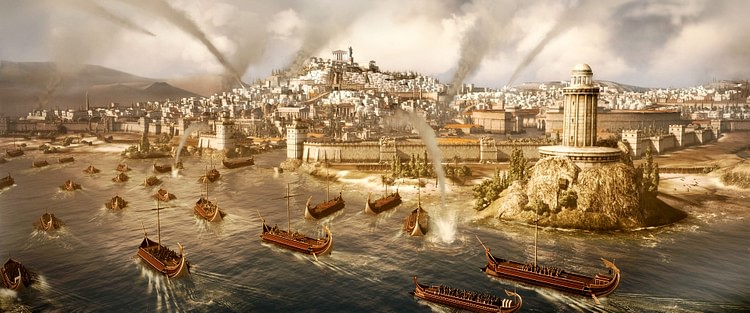
The Carthaginians were famed in antiquity for their seafaring skills and innovation in ship design. The empire their navy protected stretched from Sicily to the Atlantic coast of Africa. Able to match the tyrants of Sicily and the Hellenistic kingdoms Carthage ’s dominance of the seas would be challenged and ultimately replaced by the Romans, who were able to create a navy that became just as successful as their land army.
THE CARTHAGINIAN EMPIRE
Carthage took over the old Phoenician colonies in the Mediterranean and created many new ones so that its empire included North Africa, the Iberian peninsula, Sicily, Sardinia, Corsica, and many other islands. To maintain trade contacts between these cities and to police their interests the Carthaginians used a naval fleet which became the envy of the ancient world. Such was its strength that Rome, although successful in land battles, was forced to build its first ever fleet in order to defeat Carthage and claim the western Mediterranean for its own. For three centuries prior to the Punic Wars, though, the Carthaginian fleet ruled the waves.
CARTHAGINIAN SHIPS
Inheriting the skills passed on to them by the mother country Phoenicia the Carthaginians were admired across the ancient Mediterranean not only for their seamanship but also the quality of their ships. Such were the requirements of Carthage's large navy that ships were constructed using mass-produced pieces marked with numbers for ease of assembly. The wood used for ships was oak, fir, and pine. The size of the fleet changed depending on the period, but according to the ancient historian Polybius, Carthage had a fleet of 350 ships in 256 BCE. During the Punic Wars with Rome between 264 BCE and 146 BCE the fleet had to be constantly renewed to recover from losses in battles and storms.
THE NAVAL FLEET OF CARTHAGE WAS COMPOSED OF LARGE WARSHIPS PROPELLED BY SAIL & OARS WHICH WERE USED TO RAM ENEMY VESSELS.
The naval fleet of Carthage was composed of large warships propelled by sail and oars which were used to ram enemy vessels using a bronze ram mounted on the prow below the waterline. Direction was controlled by two steering-oars fixed to either side of the stern. Each oar was fitted with a horizontal bar for the helmsmen to handle. The Phoenicians had invented the trireme with three banks of rowers, but after using these in their early history the Carthaginians would later progress in the 4th century BCE to the bigger and faster ships with four and five men per oar, the quadrireme and quinquereme. The quinquereme, so called for its arrangement of five rowers per vertical line of three oars, became the most widely used in the Punic fleet. Catapults could be mounted on the deck of these large vessels but were probably limited to siege warfare and not used in ship-to-ship battles.
TACTICS
The main aim in a naval battle was to ram and hole an enemy vessel or break its bank of oars. Sails were not used in battle conditions, but oar-power could give a ship a speed of 7-8 knots. Crews had to be well-trained to not only manoeuvre a ship as best as possible but also know when not to drive too far into an enemy ship and so become stuck when the ram impaled it.The second stage was to assault the enemy with missiles and, if necessary, board using grappling hooks and fight hand-to-hand. Polybius describes the skills and tactics of the Carthaginian navy in battle thus,
They much surpassed the Romans in speed, owing to the superior build of their ships and the better training of the rowers, as they had freely developed their line [formation] in the open sea. For if any ships found themselves hard pressed by the enemy it was easy for them, owing to their speed, to retreat safely to open water and from thence, fetching round on the ships that pursued…them, they either got in their rear or attacked them in the flank.As the enemy then had to turn round they found themselves in difficulty owing to the weight of the hulls and the poor oarsmanship of the crews, [so the Carthaginians] rammed them repeatedly and sunk many. (quoted in Salimbeti, 49)
Attempts to ram enemy ships could be made in two ways. The first, the diekplous or breakthrough, was when ships formed a single line and sailed right through the enemy lines at a selected weak point. The defending ships would try not to create any gaps in their formation and perhaps stagger their lines to counter the diekplous. The diekplous was used with great effect in 217 BCE by a Roman fleet to defeat the Carthaginians at the battle of Ebro. The second tactic, known as periplous, was to try and sail down the flanks of the enemy formation and attack from the sides and rear. This strategy could be countered by spreading one's ships as wide as possible but not too much so as to allow a diekplous attack. Positioning a fleet with one flank protected by a shoreline could also help counter a periplous manoeuvre, especially from a more numerous enemy. While all this chaotic ramming was going on, smaller vessels were used to haul stricken ships away from the battle lines or even to tow away captured vessels.
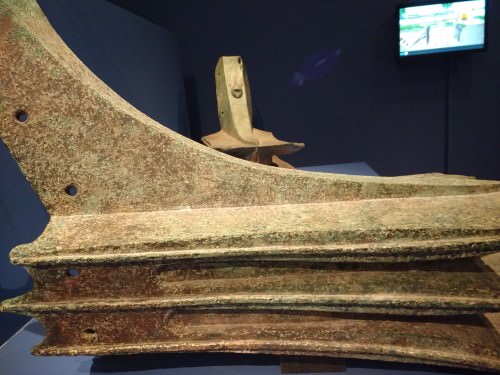
Carthaginian Ship's Ram
Aside from naval battles, the Carthaginian fleet was also vital for transporting armies, resupplying them by providing an escort for transport ships, coastal raids, attacking enemy supply ships, blockading enemy ports, and relieving Carthaginian forces when they were themselves besieged. The Carthaginian navy was also employed to sink trading vessels from rival states if they attempted to promote commercial activity in places Carthage considered it held a trade monopoly.
COMMANDERS & CREW
Command of the navy was in the hands of an admiral selected by the council of Carthage. He had equal status to the commander of the land army, and only very rarely were the two forces commanded by the same person. Each ship was run by three officers, one of whom was the navigator. A typical quinquereme crew would have consisted of 300 rowers taken from the citizenry of Carthage and allied cities such as Utica. In later times slaves were also used to meet the high demands of warfare. The lesser-skilled slaves could be used to good effect in the larger ships where two men manipulated most of the oars. This arrangement allowed one skilled oarsman to guide the oar but also benefit from the power of the second man. The find of the Marsala shipwreck, a 3rd-century BCE Carthaginian naval vessel that sank off Sicily, revealed not only the labelled pieces of the ship's hull for easy assembly but also what the crew ate and drank: dried meat (poultry, horse, beef, goat, pork, and venison), almonds and walnuts, washed down with wine.
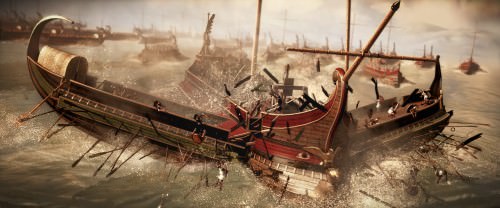
Ancient Naval Battle
Oarsmen could not relax when beached as they were expected to fight in landing operations but not in ship-to-ship battles.Crews might also be employed in the building of siege engines, too. The larger ships were decked and would have carried complements of armed men, both archers and marines armed with spears, javelins, and swords, who could board enemy vessels given the opportunity.
THE HARBOUR OF CARTHAGE
The Punic naval fleet had its own harbour separate from but connected to the merchant harbour at Carthage. The naval harbour was massive and circular whilst the merchant ships anchored in a rectangular one. Both ports were manmade, about two metres deep, and they possibly date to 220-210 BCE. The centre of the naval harbour was dominated by a tower structure known as the 'the admiral's island' which connected to the outer ring via a causeway. Appian gives an idea of the great size of the naval harbour by describing the central island's capacity for 30 ships and the 21-metre wide entrance. The outer ring of ship sheds could hold another 170 ships. From recent archaeology we now know that the harbour was 325 metres in diameter and matches Appian's description. The roofed sheds fronted by Ionic columns allowed the relatively light wooden ships to be pulled up a wooden slipway for repair and to avoid them becoming water-logged when not needed. The sheds were 30-48 metres long and 6 metres wide. The harbour also had a large platform ( choma ) which infantry and even chariots could use to board the ships. Both harbours were protected by massive fortification walls.
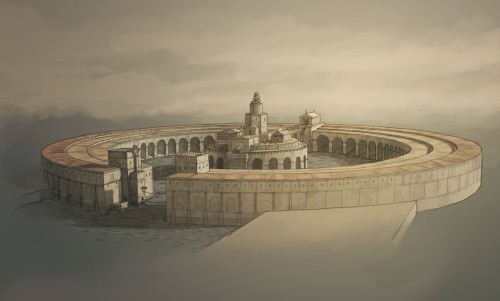
Naval Harbour of Carthage
KEY SEA BATTLES
Greek States & Syracuse
The first known sea battle involving the Carthaginian navy was in 535 BCE against the Phocaeans off Corsica. Carthage's seemingly never-ending battle for control of Sicily produced many naval battles throughout the 5th and 4th centuries BCE with losses more or less equalling victories. Wars against Dionysius I of Syracuse (four), Timoleon, and Agathocles all saw naval engagements, blockades, and coastal raids. Carthage also provided its fleet for logistical support to the Romans in their waragainst Pyrrhus in the early 3rd century BCE. However, the best documented naval engagements, and those most vital to Carthage's survival, came during the Punic Wars with Rome now as enemy number one.
First Punic War
In the First Punic War (264 and 241 BCE) Rome quickly realised that to defeat Carthage they would have to do what they had never done before - build their own naval fleet. Accordingly, in the spring of 260 BCE, Rome constructed a fleet of 20 triremes and 100 quinquereme warships in only 60 days. Copying the design of a captured Carthaginian ship, the Romans then added a whole new feature: the corvus (raven). This was a rotating 11-metre long platform with a giant holding spike (like a beak, hence the bird name) which could be lowered onto an enemy vessel to allow a heavy infantry unit (perhaps 80-120 men) to board them. The idea would negate the superior seamanship of the Carthaginians and make naval combat more like a land battle. This masterstroke of inventiveness was an immediate success when their fleet of 145 ships defeated the Carthaginian fleet of 130 ships at the battle of Mylae (Milazzo) in 260 BCE. The Carthaginians, so dismissive of their opponent's seafaring skills, had not even bothered to form battle lines. When the Carthaginian flagship was captured, the commander was forced to flee in a rowing boat. The Roman commander Duilius was honoured with a Roman triumph, the first in Rome's history to be awarded for a naval victory.
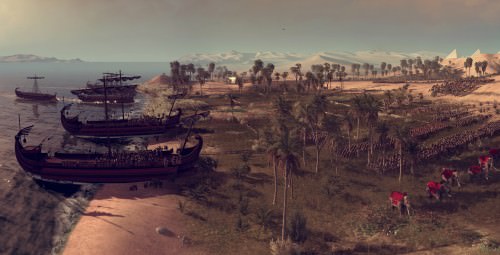
Naval Landing
Carthage seemed to have no answer to the corvus and more defeats came at Sulcis in 258 BCE and in the battle of Ecnomus in 256 BCE. The latter was one of the largest naval engagements in history with the Romans commanding 330 ships and the Carthaginians a similar number. The Romans formed four distinct battle groups which disrupted the Carthaginian lines. 100 of the enemy ships were destroyed compared to 24 Roman losses.
Carthage fought back in 249 BCE with an important victory at Drepana (Trapani) where their superior seamanship saw them outmanoeuvre the Roman fleet out at sea. The Carthaginian fleet was ably led by Adherbal who captured 93 of the 120 enemy ships. The Roman commander, Publius Claudius Pulcher, who had rashly decided to attack at night, was tried for treason back in Rome. Round one of the Punic Wars was finally won by the Romans with their victory off the Aegates Islands (Isole Egadi) on 10th March, 241 BCE. The Carthaginian fleet, led by Hanno and sent to relieve the besieged city of Drepana on Sicily, was defeated by a 200-ship Roman fleet commanded by the consul Gaius Lutatius Catulus. Catulus had spent all the previous summer training his crews and the effort paid off when 50 Carthaginian ships were sunk, 70 captured, and 10,000 prisoners taken. This loss was not huge, but after decades of war, it drove the cash-strapped Carthaginians to seek peace terms.
Second Punic War
The Second Punic War (218-201 BCE) was largely fought on land, but the fleets of both sides were crucial in transporting land armies, resupplying them, and blockading ports throughout the conflict. Hamilcar Barca had already sailed in 237 BCE with an army to conquer much of southern Spain. In 216 BCE the fleet was used to transport an army to Sardinia in a failed attempt to take back the island and another army to Spain to relieve the pressure from Scipio Africanus the Elder. In 213 BCE an army was transported to Sicily, but again the Carthaginians could not prevent Marcellus from taking Syracuse. In 205 BCE Carthage sent yet another army, led by Mago, to relieve his brother Hannibal who was by now cornered in southern Italy. Unfortunately, they could only land in Liguria, northern Italy because of the Roman naval dominance and their control of the major ports further south. In 204 BCE Scipio managed to cross to Africa unimpeded with an army of 30,000 men. In 202 BCE the Roman general then defeated an army led by Hannibal at the Battle of Zama. The second and most decisive round was over with Rome once again the victor.
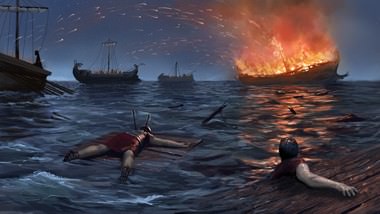
Roman Naval Warfare
Land battles had been decisive in the war but so too had Carthage's lack of naval dominance. Crucially, Carthage had not been able to resupply Hannibal, join the armies of the two brothers together, or prevent Scipio from landing in Africa. The Roman dominance of the seas following the First Punic War had made them unstoppable. Part of the peace terms after the Second Punic War stipulated that Carthage could never again possess a fleet and the once great navy was limited to a paltry 10 ships.
Third Punic War
The Third Punic War (149-146 BCE) turned out to be something of a mismatch. Carthage, without a navy, could do nothing to prevent the Romans landing an army of over 80,000 men in North Africa. Despite valiant resistance behind Carthage's impressive fortifications and a brave attempt to break the siege with a fleet of 50 secretly constructed ships, Rome was able to carry out the senator Cato's famous command to the letter, Carthage was destroyed. Rome had lost 600 ships in the Punic Wars (most of those due to storms) and more men than its opponent but its ability to replace them and the superiority of the land army meant Carthage was not only defeated time and again but the city obliterated and the population sold into slavery.
CONCLUSION
The Carthaginian navy had initially been the Mediterranean's innovators in ship design and they had enjoyed many victories against multiple enemies but by the time of the Punic Wars the world had changed. Very few ancient wars up to that time were ever settled by sea engagements alone as land warfare remained the principal means to inflict total defeat on the enemy. Even before the Punic Wars had started, Carthage had gone a generation without having to fight a naval battle with the consequence that its mariners had little real battle experience. Rome took up naval warfare with great success and displayed an astounding ability to replace its fleets almost at will. In Spain and North Africa Romans defeated the Carthaginian armies on land. Hannibal's four great victories in Italy proved to be the exception, not the rule, and his gamble that Rome would collapse from within failed. Thus, Rome, with its professional army and navy of highly-trained and well-disciplined troops led by a clear command structure lusting for military glory within their term of office, swept aside Carthage both on land and at sea. Carthage was not helped by overly-conservative commanders but, in any case, it simply did not have the military or financial means to compete with the Mediterranean's new superpower. Ancient warfare had evolved into a multi-weapon, multi-trooped, and multiple theatre activity at which the Romans excelled above all others.
Carthaginian Religion › Origins
Definition and Origins
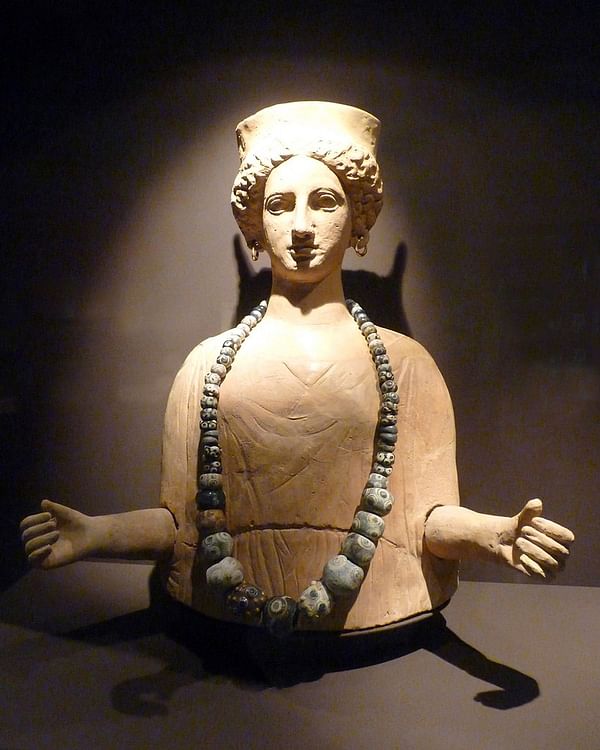
Carthage was founded by the Phoenician city of Tyre in the 9th century BCE, and along with many other cultural practices, the city adopted aspects of the religion of its founding fathers. Polytheistic in nature, such important Phoenician gods as Melqart and Baal were worshipped in the colony alongside new ones such as Tanit. These, in turn, were spread to new Puniccolonies around the ancient Mediterranean while in the other direction gods from neighbouring cultures were incorporated into the Carthaginian pantheon. Temples were built in their honour, ceremonies were overseen by a priestly class, sacrifices were made to appease them, and their imagery appeared on ships, coins, and in the arts.
THE GODS
Most Carthaginian gods were inherited from the Phoenicians, but these were adapted, and their names and functions evolved over time. The most important Carthaginian deity was Melqart, patron and protector of the city of Tyre and perhaps given a similar role in early Carthage. Indeed, the colonists were obliged to send annual tribute - one-tenth of their annual profits - to the temple of Melqart at Tyre for the first few centuries of the colony's existence. In the 3rd century BCE the influential Barcid clan of Carthage were particularly keen worshippers of Melqart. Hannibal famously swore an oath to the god in 237 BCE when, aged 9, he stated that he would forever be the enemy of Rome. Hannibal, too, was not the only Carthaginian general that deified himself and took on the appearance of the god. The Greeks identified Melqart with their own hero Hercules, and a cult of Melqart-Hercules spread around the Mediterranean.
Baal Hammon ('lord of the altars of incense') was another important god, inspired by the Baal who was supreme god at the Phoenician city of Sidon. Baal had many other incarnations, or perhaps even separate deities under that name: Baal Iddir, Baal Marqod, Baal Oz, Baal Qarnem, Baal Sapon, and Baal Shamin. Historians, such is the lack of clarity on the specifics of Phoenician and Carthaginian gods, continue to discuss his association or even equivalence to Melqart and the Phoenician god El.
THE MOST IMPORTANT GODDESS WAS TANIT, WHO REPRESENTED A MOTHER GODDESS, LIFE, & FERTILITY.
Similarly, the Phoenician gods Eshmun (an equivalent of Adonis but also identified as Asclepius by the Greeks, suggesting he had an association with healing at Carthage), Reshef (the god of fire and lightning, linked to Apollo by the Greeks), and Rasap (associated with warfare ) were worshipped at Carthage but again with slightly different connotations such as Reshef (a form of Rasap) and Shadrap (associated with snakes and healing). Less important Phoenician gods surviving in Punic religion included Hawot (god of the dead), Hudis (the new moon), Kese (the full moon), Kusor/Kusorit (god/goddess of intelligence), and Semes (the sun goddess).
One of the most important Punic deities that were not worshipped in Phoenicia was Tanit ( Tnt ), although she may have been considered an attendant of Astarte there. Tanit came to prominence only from the 5th century BCE at Carthage, but she would eventually supersede Melqart and Baal Hammon in importance. She represented a mother goddess, life, and fertility. Strongly linked to Baal and considered the consort of Baal Hammon, she was commonly referred to as 'Tanit face of Baal' ( Tnt pn B'l ) and represented in inscriptions, mosaics, pottery, and stelae as a symbol (a triangle with a straight line and circle above it) seemingly representing a stylised female figure with arms outstretched. No other symbols are known of the other Carthaginian gods. Tanit was also associated with the palm tree, dove, the moon, fish, and pomegranate, all of which appear with her on Carthaginian coins and stelae dedicated to her. In later sculpture, she is most often portrayed with a lion's head and wings, and a second symbol of her is the bottle shape prevalent on votive stelae.
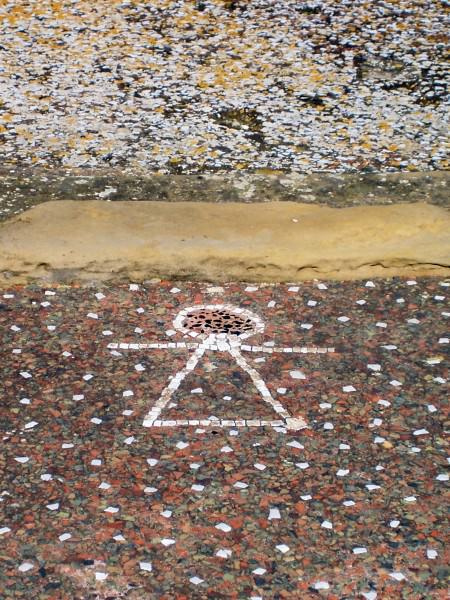
Tanit Mosaic
Finally, gods were adopted and adapted from the Greek pantheon following the increasing Hellenization of Carthage from the 4th century BCE. Demeter and Persephone (Kore) were especially popular and were incorporated into the Punic pantheon following a series of military disasters which the Carthaginians ascribed to their unwise destruction of the goddesses' temple at Syracuse in 396 BCE. High ranking priests and priestesses were specifically assigned to serve the goddesses. Another foreign import was Isis, who had a temple in the city. One of the goddess' priestesses is depicted on a stunning marble sarcophagus lid from the St. Monique tomb. The use of Egyptian-made and home-copied amulets was widespread at Carthage judging by their abundance in tombs.
THE PRIESTS
In the founding legend of Carthage, Dido ( Elissa ), the queen who fled from Tyre, picked up the High priest of Astarte in Cyprus on her way to North Africa, promising him that he and his descendants would hold the position of High Priest in the new city. This was the first of a priestly class at the city. The elite class of Carthage dominated the important religious posts.The head of the priests ( rb khnm ) was also a member of the Senate and the influential Council of 104. A committee of 10 senators was responsible for state religious matters. Priests would have enjoyed a high status but lived an austere life, symbolised by their distinctive shaved heads. Priests made themselves even more distinguished by painting themselves with red ochre during ceremonies. The majority of the city's religious positions seem to have been hereditary. Inscriptions inform us that a chief priest was responsible for a particular temple and assisted by a lower category of priests ( khnm ). There were female priests, but once again, the details of initiation and duties of the priestly class remain unknown. Priests may have controlled education, of which we know very little, and also the libraries we know existed at the time of Carthage's destruction in 146 BCE.
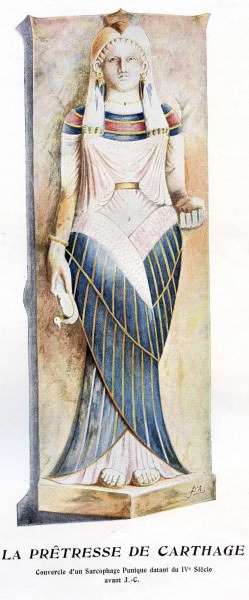
Priestess of Isis on a Carthaginian Sarcophagus Lid
THE TEMPLES
Inscriptions on Punic stelae describe many temples to many different deities at Carthage, but unfortunately, very little remains of them exist in the archaeological record due to the destruction of the city by the Romans at the end of the Third Punic Warin 146 BCE. There were probably as many temples at Carthage as at the contemporary cities of Rome and Athens. We can imagine they were similar to Phoenician temples such as Solomon ’s described in the Bible as designed by Phoenicians and Melqart's temple at Tyre, described by Herodotus. These had two large columns, one either side of the entrance which led to three chambers within which was not a representation of the god but a large bronze bowl with an eternal flame.
It was outside the temples that ceremonies were carried out such as prayers, burning incense, and making offerings to the gods at a specially dedicated altar. These could take the form of the pouring of libations, food offerings, flowers, animal sacrifice (bulls, lambs, poultry, birds etc.), and even human sacrifice ( molk ). We also know that temples were off-limits to women and pigs, although there were some priestesses who served certain deities and their temples. Religious ceremonies could also take place at natural features like rivers and springs as these were often held as sacred by the Carthaginians.
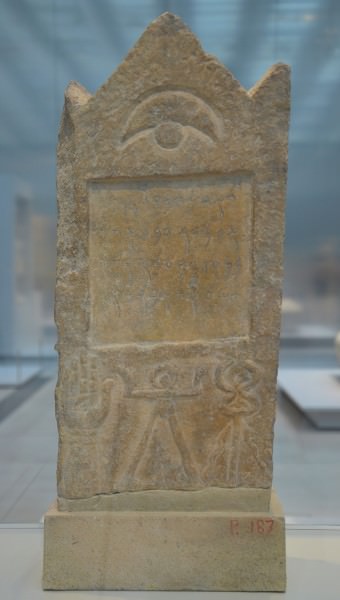
Punic Stele with Goddess Tanit
THE TOPHET
One of the rituals of the Phoenician and Punic religions was to sacrifice humans, especially children (but not only), according to ancient sources. The victims were killed by fire, although it is not clear precisely how. According to the ancient historians Clitarch and Diodorus, a hearth was set before a bronze statue of the god Baal (or El), who had outstretched arms on which the victim was placed before falling into the fire. They also mention the victims wearing a smiling mask to hide their tears from the god to whom they were being offered. The victim's ashes were then placed in an urn topped with a stone. The urns themselves were often recycled pots and jars from as far afield as Corinth and Egypt and so provide an interesting and valuable record of Mediterranean trade. From the 6th century BCE, stelae were dedicated to Baal or Tanit and placed on top of the urns instead of stones. Thousands of examples survive of these votive markers and are powerful evidence that the Carthaginian religion was practised by all levels of society. Some urns were buried in shaft tombs and the dedicated sacred open space for these urns was surrounded by walls and known as a tophet.
The tophet at Carthage was known as the 'precinct of Tanit' and located to the south of the city at Salammbo. It was first used in the 8th century BCE and continuously thereafter until the fall of Carthage in the Punic Wars. At its largest extent, it covered 6,000 square meters and has nine descending levels. There is a shrine area with an altar where the sacrifices were made.
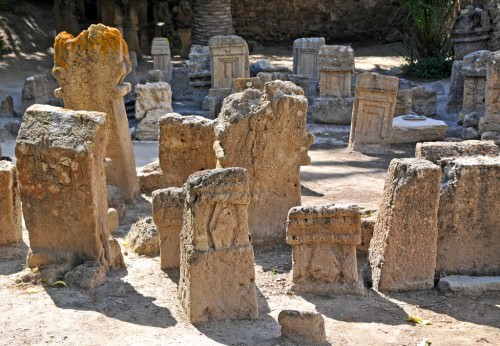
Tophet of Carthage
In the ancient world, the Phoenicians and Carthaginians earned a bloody reputation for frequent child sacrifice, but some historians have questioned the scale of this practice. Many stelae have an inscription which describes a human blood sacrifice, but others describe the substitution of a sheep or lamb for a child. Further, on closer inspection, it is notable that all of the literary references to human sacrifice suggest that it was necessary only in times of great danger to the state such as wars, plagues, and natural disasters, and was not an everyday practice. Even in Phoenician/Punic mythology, where the god El sacrifices his son Ieud, it is to save his country from collapse. In another example, Diodorus describes the Carthaginian general Hamilcar sacrificing a child during the siege of Agrigento in the 5th century BCE when the defenders were suffering from a fatal outbreak of disease. Further, human sacrifices in ancient sources are almost always the children of rulers and the ruling class, as the gods, apparently, were not to be moved by the sacrifice of the common people.
Analysis of the remains found within the urns at Carthage reveals that, overall, 80% of the human remains are from newborn babies or foetuses. This is similar to the percentage at other tophets such as on Tharros. The exact cause of death is not possible to determine, but historian ME Aubet concludes the following,
...everything points to them dying of natural causes, at birth or a few weeks later. Although human sacrifice may have been practised, the high proportion of newborn babies in the tophets shows that these enclosures served as burial places for children who died at birth or had not reached the age of two. (252)
Aubet also notes that the cemeteries of Punic cities do not contain the remains of young children, suggesting that all children, no matter the cause of death, were buried within the tophet. Child sacrifice did occur at Carthage, as it did in many other ancient cultures, but the physical evidence of the scale of such a practice does not seem to match the long-held infamous reputation the Phoenicians and Carthaginians have suffered from since antiquity.
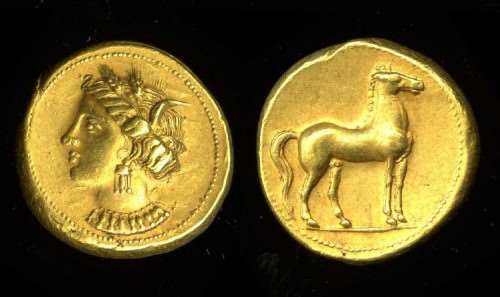
Tanit, Carthaginian Electrum Coin
CONCLUSION
Our information on many of the details of the Punic religion is, then, incomplete due to a lack of contemporary sources from the Carthaginians themselves. The situation is made more complex by the sometimes indiscriminate use of Greek and Latin names by ancient writers of those cultures when describing Carthage's religious practices, not to mention their bias against foreign practices. No temples survive, no texts on the Punic mythology have come down to us, and we are left only with a number of inscribed stelae and certain art objects to piece together the details. Tombs have been a vital source of such objects, and the presence of votive offerings, day-to-day utensils, amulets, and masks to ward off evil spirits would suggest that the Carthaginians did believe in some sort of after-life. As with many other aspects of the Carthaginian religion, though, we do not know any precise details and we are left wondering what that life entailed or how a person could assure they ever got there. More certain is that the Carthaginian religion continued, beyond the Roman destruction of the city, to be practised, sometimes under different names, perhaps more clandestinely than previously, but very often at the same temple sites as before.
The Nimrud Dogs › Origins
Ancient Civilizations
In 612 BCE the Neo-Assyrian Empire fell to the invading forces of Babylonians, Persians, Medes, and Scythians. The empirehad been expanding in every direction since the reign of Adad Nirari II (c. 912-891 BCE) and grew more powerful under great kings such as Tiglath Pileser III (745-727 BCE), Shalmaneser V (727-722 BCE), Sargon II (722-705 BCE), Sennacherib(705-681 BCE), and Esarhaddon (681-669 BCE) until, by the time of Ashurbanipal (668-627 BCE), it had grown too large to manage effectively. Ashurbanipal was the last of the Assyrian kings who had the personal power and skill to manage an empire, and after he died the vassal states recognized their chance to free themselves. The many regions which had been held so tightly under Assyrian control seized on the weakness of the fracturing empire and, banding together, marched to destroy it.
All of the great Assyrian cities, many of which had endured for millennia, were sacked and their treasures carried off, destroyed, or discarded at the various sites. The Assyrians had held the region under such a tight grip that, once it was loosened, the former subject-states knew no restraint in venting their frustrations and seeking revenge for past injustices.Great cities such as Nineveh, Kalhu, and Ashur were sacked, with Nineveh so thoroughly destroyed that future generations could not even tell where it had been.
EXCAVATIONS & DISCOVERY
At Kalhu, site of one of the former capitals of the empire, the sands of Mesopotamia gradually covered the ruins, and the cityprobably would have been forgotten were it not for the prominent mention of Mesopotamian cities such as Babylon and Nineveh in the Bible. In the 19th century CE European explorers, seeking historical evidence for biblical narratives, descended upon Mesopotamia and recovered these lost cities. Among these was Austen Henry Layard (1817-1894 CE) who was the first to systematically excavate Kalhu, afterwards known as Nimrud.
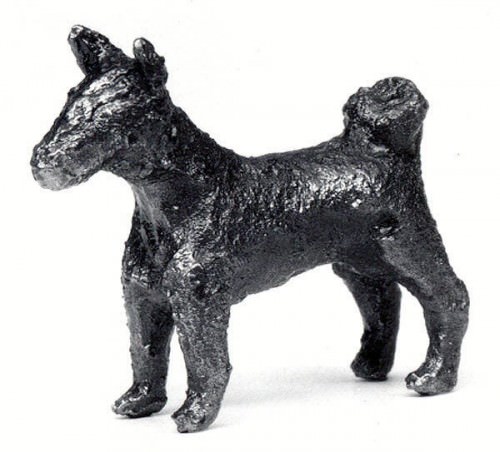
Dog Figurine from Nimrud
Layard and the others were sponsored by European organizations and museums who hoped their efforts would uncover physical evidence proving the historical accuracy of the Bible, specifically the books of the Old Testament. These expeditions, however, had a completely different effect than what was intended. Prior to the mid-19th century CE, the Bible was considered the oldest book in the world and the narratives thought to be original works; the archaeologists discovered that contrary to this belief Mesopotamia had created narratives of the Great Flood and the Fall of Man centuries before any of the biblical books were written.
These discoveries increased European interest in the region, and more archaeologists and scholars were sent. When Layard began his work at Kalhu, he did not even know which city he was excavating. He believed he had discovered Nineveh and, in fact, published his bestselling book on the excavation, Nineveh and its Remains, in 1849 CE, still confident of his conclusions.His book was so popular and the artifacts he uncovered so intriguing that further expeditions to the region were quickly funded.Further work in the region established that the ruins Layard had uncovered were not those of Nineveh but of Kalhu, which the scholars of the time associated with the biblical Nimrud, the name the site has been known by ever since.
THE NIMRUD IVORIES
Layard's work was continued by William K. Loftus (1820-1858 CE) who discovered the famous Nimrud Ivories (also known as the Loftus Ivories). These incredible works of art had been thrown down a well by the invading forces and perfectly preserved by the mud and earth which covered them. Historian and curator Joan Lines of the Metropolitan Museum of Art describes these pieces:
The most striking objects from Nimrud are the ivories - exquisitely carved heads that once must have ornamented furniture in the royal palaces; boxes inlaid with gold and decorated with processions of small figures; decorative plaques; delicately carved small animals. (234)
The discovery of the ivories suggested there could be even greater finds buried in the former wells, crypts, and ruined buildings of the cities and further expeditions to Mesopotamia were funded. Throughout the rest of the 19th and into the 20th century CE, archeologists from all over the world worked the sites of the region, uncovering the ancient cities and retrieving artifacts from the sands.
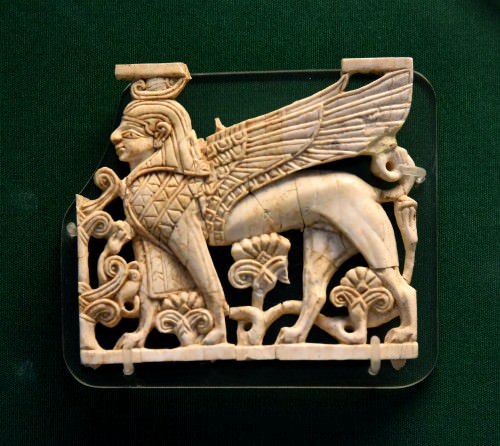
Nimrud Ivory Plaque of an Egyptian Sphinx
In 1951-1952 CE, the archaeologist (and husband of mystery writer Agatha Christie) Max Mallowan (1904-1978 CE) came to Nimrud and discovered even more ivories than Loftus had. Mallowan's discoveries, in fact, are among the most recognizable from museum exhibits and photographs. The ivories are routinely cited, naturally, as Mallowan's greatest find at Nimrud, but a lesser-known discovery is of equal importance: the Nimrud Dogs.
DOGS & MAGIC
Dogs featured prominently in the everyday life of the Mesopotamians. The historian Wolfram Von Soden notes this, writing :
The dog (Sumerian name, ur -gi; Semitic name, Kalbu) was one of the earliest domestic animals and served primarily to protect herds and dwellings against enemies. Despite the fact that dogs roamed freely in the cities, the dog in the ancient Orient was at all times generally bound to a single master and was cared for by him. (91)
Dogs were kept as pets but also as protectors and were often depicted in the company of deities. Inanna (later Ishtar ), one of the most popular goddesses in Mesopotamian history, was frequently depicted with her dogs, and Gula, goddess of healing, was closely associated with dogs because of the curative effect of their saliva. People noticed that when a dog was injured it would lick itself to heal; dog saliva was considered an important medicinal substance and the dog a gift of the gods. The dog, in fact, became a symbol of Gula from the Old Babylonian Period (c. 2000-1600 BCE) onward.
THE DOG STATUETTES DID NOT REPRESENT BELOVED PETS BUT DIVINE PROTECTION. THEY WERE CREATED TO KEEP SAFE THE PEOPLE ONE CARED FOR.
The dog as a protector, however, was as important as its role as healer. During the time of Hammurabi 's reign (1792-1750 BCE), dog figurines were regularly cast in clay or bronze and placed under thresholds as protective entities. The scholar EA Wallis Budge, writing on discoveries at the city of Kish, notes how "in one room two clay figures of Papsukhal, messenger of the gods, and three figures of dogs were found: the names of two of the dogs are inscribed on them, viz., 'Biter of his enemy' and 'Consumer of his life'" (209). After a ceremony 'awakening' their spirit, these dogs were positioned in buildings to defend against supernatural forces. Joan Lines describes the purpose of these figures further:
Such figurines, made of clay or bronze, were symbols of the Gula-Ninkarrak, goddess of healing and defender of homes. They were buried beneath the floor, usually under the doorstep, to scare away evil spirits and demons and an incantation called "Fierce Dogs" was recited during the ceremony. Many of the dog effigies had their names inscribed on them. (242-243)
These dog statuettes are significant in understanding the Mesopotamian concept of magic and magical protection. The Mesopotamians believed that people were co-workers with the gods to maintain order against the forces of chaos. They took care of the tasks the gods had no time for. In return, the gods gave them all they needed in life. There were many gods in the Mesopotamian pantheon, however, and even though one might mean a person only the best, another could have been offended by one's thoughts or actions. Further, there were ghosts, evil spirits, and demons to be considered. The Mesopotamians, therefore, developed charms, amulets, spells, and rituals for protection, and among these were the dog statuettes.
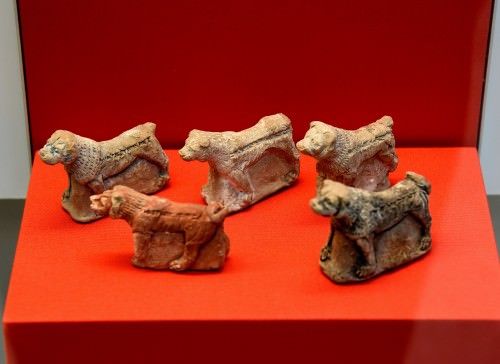
Model Clay Dogs from Nineveh
The Mesopotamians believed that their actions, however small, were recognized and rewarded or punished by the gods and what they did on earth mattered in the heavens. The creation of the dog statuettes drew on the protective power of the spirit of the dog as an eternal and powerful entity, and, through rituals observed in their creation, the figures were imbued with this power. Scholar Carolyn Nakamura comments on this:
Through this production of figurines, Neo-Assyrian apotropaic [evil-averting] rituals trace out complex, and even disorienting, relations between humans, deities, and various supernatural beings in space and time...the creation of powerful supernatural beings in diminutive clay form mimes the divine creation of being from primordial clay.(33)
Just as the gods had created humanity, humans could now create their own helpers. Once created, the dogs performed their important function of protection in concert with other magical artifacts. At Nimrud, Mallowan discovered magical boxes in the rooms of houses which also served to protect the inhabitants. The boxes would be placed in the four corners of a room and often at the four points where a bed would have rested, and were carved with charms to protect against evil spirits and demons. The dogs, buried beneath the entranceways to the home, were the first line of defense against supernatural dangers and the amuletic boxes inside the house provided an added degree of comfort and security.
THE NIMRUD DOGS
The rituals surrounding dog figurines are exemplified by the location of a set of five such figures discovered by Layard in the 19th century CE at Nineveh. These were all found under a doorway of the North Palace, and this is in keeping with the practice described above. To ensure maximum protection, it was recommended that one bury two sets of five such figures on either side of a door or beneath the doorway.
At Nimrud, Mallowan found the dog statuettes in a well in the corner of a room of the Northwest Palace. The discovery is described by scholar Ruth A. Horry:
Mallowan's team came across a deep well in the corner of Room NN which was filled with sludge that Mallowan described as being "the consitency of plaster of Paris ". No electric pumps were available to dig out the well so the workmen had to scoop out the water and sludge by hand, aided only by the heavy-duty winching equipment borrowed from the Iraq Petroleum Company. It was difficult and dangerous work as the well bottom repeatedly filled up with water...[however] the sludge had provided ideal conditions for preserving materials that would otherwise have decayed, such as fragments of Assyrian rope and wooden well equipment that had accidentally fallen in. (1-2)
Among these other objects were those which had been purposefully thrown into the well during the sack of the city, and included in these were the ivories and the dog statuary. Mallowan interpreted these pieces as being discarded during the destruction of Nimrud - rather than simply thrown in the well by their owners - based on other articles, such as foreign horse harnesses, found with them.
Five of the dog figures were clearly canine and some had their names inscribed on them (just as the ones found at Nineveh did), but the sixth had no name and, further, looked more like a cat. The cat was never considered a protective entity in Mesopotamia, however, and cats are not represented by any amulets or statuary. Horry writes:
Omens portray [cats] as wild animals, at best untameable ones, that wandered in and out of houses at will.Humans and cats lived around each other but did not engage directly...in other words, the inhabitants of Kalhu, even the king in his palace, could not rely on cats to guard a building, whether from mice or more supernatural forces. (2-3)
Mallowan had difficulty in interpreting the piece for this reason: although it looked like a cat, there was no precedent for cat figures or for cats represented in amuletic imagery at all. In his initial reports, he cites the discovery of five dog figurines and one other which was "feline in character" (Horry, 5). The preponderance of evidence, however, argued against interpreting the figure as a cat, and Mallowan later seems to have believed that it was a dog with a "feline appearance" (Horry, 5). Mallowan delivered his finds to the Iraqi authorities, and in keeping with his contract, some went to the Iraqi Museum and some to other institutions. The 'cat' figure was reinterpreted by the British scholars at Cambridge as a cat and remained so until 2013 CE when the figurines were studied as a group and it was recognized that the cat figure was another dog.
THE DOGS TODAY & THEIR SIGNIFICANCE
The dog figures found at Nineveh are in the British Museum today while the Nimrud Dogs can be found in museums at Baghdad, Iraq; Cambridge, England ; New York, America, and Melbourne, Australia. The figures from the Iraq Museum were left untouched in the looting of 2003 CE and remain a part the permanent collection.
Visitors to these museums quite rightly marvel at exhibits of Mesopotamian art such as the famous Nimrud Ivories but often overlook the dog figurines. Even in those exhibits where their history is told, the focus is largely on their discovery with only brief mention of what they meant to the people who created them. Often, it seems, the small dogs are interpreted by visitors as representations of ancient pets. The dog statuettes did not represent beloved pets, however, but divine protection. They were created to keep safe the people one cared for. Centuries ago, people crafted the dog figures, gave them life through ritual, and buried them beneath their doorway for peace of mind.
In the same way, an individual living today might install a security system in the home, make sure doors and locks are secure, perhaps even hang a religious symbol or totemic talisman near the door. The Nimrud Dogs are significant artifacts because they are so personal. Nakamura comments on their creation and use, noting how "an idiom of protection arises in material enactment of memory" (33). The "enactment of memory" in the past had to do with the awakening of the spirit of the dog in the figurine. Today, however, the Nimrud Dogs evoke the spirit of the past and the memory of those who created the figures to protect themselves and those they loved from harm.
LICENSE
Article based on information obtained from these sources:with permission from the Website Ancient History Encyclopedia
Content is available under License Creative Commons: Attribution-NonCommercial-ShareAlike 3.0 Unported. CC-BY-NC-SA License